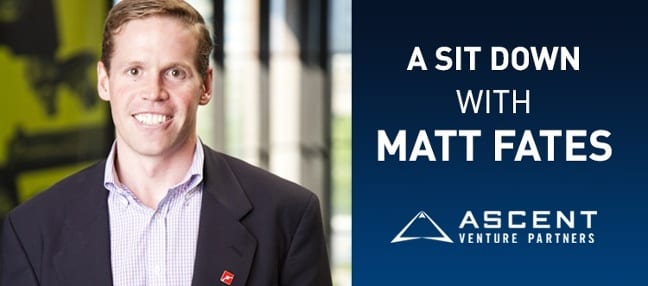
Here at PAN we work with a lot of companies in the “emerging growth” phase. They have great ideas, solid teams in place and strategies to reach the next level. They’re scaling up rapidly and PR is an important tool in their growth plans.
So is venture capital. Many of these younger companies have grabbed some seed funding and maybe an early round of capital, and they’re either seeking a follow-up round or tapping those funds to execute their break-out plans.
Ascent Venture Partners, of Boston, focuses squarely on early-stage investments in enterprise IT companies on the East Coast. We’ve talked often with Ascent’s VCs over the years – sometimes through connections with clients and other times on elevator rides, since Ascent’s offices are located three floors below PAN at 255 State Street.
Given the common interests of VC and PR, we recently invited Matt Fates, an Ascent general partner, to meet with PAN’s staff to share some thoughts about investing, building companies, the importance of branding and the strength of the Northeast’s IT sector.
Here are a few of Fates’ insights:
Ascent reviews more than 1,000 deals a year and invests in three or four. To reach Ascent’s short list, a company needs to stand out from the crowd.
“Great companies grow fast, and they do it on relatively modest capital,” Fates said. “At the highest level, we look for companies that can really scale. If you’re not doubling every year, you’re not growing enough…. Our preference is to look for people who have some experience. We’re not backing people right out of college. We want someone who has gained insight into the world and has experience solving real problems… We also want that bigger ambition – that type of ‘I can change the world’ kind of attitude, as well.”
A successful PR program won’t tip the scales in terms of convincing a VC to invest.
“It doesn’t matter so much to us. I think it matters way more to customers. If we perceive that PR is being very effective at helping them create customer awareness and get some buzz going, that’s great. On the investment side, brand equity plays a role – but not nearly as much as other key factors we evaluate.”
VCs don’t give a higher priority to companies that have a strong reputation among other VCs. In fact, they prefer companies that have a low profile.
“We like companies who others in the investment community don’t know anything about. We’re competing with them to some degree. Because we’re going to have to compete with (other VCs) as far as a valuation and partnership, we want to find the needles in the haystack that are really special and that no one knows about.”
VCs value companies that put a heavy emphasis on thought leadership.
“Seeing companies do thought leadership – that’s good. We like to see companies have an active and meaningful blog. Frequency doesn’t matter so much. (The question is:) Are you saying things that are new and that people aren’t reading everywhere?”
Having a strong technology evangelist, who has developed a following, can be an important factor for a young company looking to carve out its own identity.
“There are categories of technology where having a really strong CTO is more important. You want them to get their voice out — be seen as a thought leader and a category leader, where companies look to and respect what they have to say.” (Fates discussed how a CTO of a security company he knows draws crowds at Vegas hacking events.) “He’s a little bit of a rock star. Having someone like that be an evangelist can be really helpful in accelerating awareness and adoption.”
The move from an “A round” of venture capital to a “B round” is an important one.
“A’s are about increasing your customer base to more than just a few customers that were probably sold by the CEO. When you get through that A money you want to prove that a small sales team can replicate what they started to do. There’s some predictability of bringing in leads, bringing them into opportunities and closing a percentage of them. That gets you up to about $5 million in revenue. The B round is about starting to scale. We want to turn this into a team. We want to turn on social and really lean into marketing and sales. You’re looking for a lot more evidence that it’s going to work. Leaning into sales and marketing will start to scale the company.”
Some entrepreneurs have a hard time adapting to a new structure where they need to report to VCs and others on a board.
“It’s not just your company anymore. It’s still your company, but it’s a lot of other people’s company too. It’s a very different mindset. But, from my experience, it’s a lot like telling somebody how to raise a child. It just doesn’t sink in. They have to learn it for themselves. I think some people, if they talk to enough other entrepreneurs, are pretty well prepared. But others view it as almost an end to a means. ‘Oh, I raised money. I’m a big success.’ No, this is just a step on the path. If you don’t treat that money dearly and efficiently, you will be replaced.”
Still, VCs prefer to try to keep the entrepreneur in place.
“I always like to leave a founder in place as long as possible. They’re like the spirit — the soul of a company — and you don’t want that spirit missing from the DNA of the company.”
VCs tend to spend a lot more time and energy on companies that struggle to break through.
“The winners, for the most part — get out of their way. Help them, push them, but certainly don’t impede them. You spend more time on the strugglers.”
While investors push VCs to commit larger outlays on successful, high-growth companies, it’s not that easy.
“Most of our investors expect us to put more money in the winners. That’s hard to do. The ones that take off, the next valuation is at $200 million, which makes the model a bit more difficult to work for us. It’s actually very hard to tip that balance where you’re putting more money into good companies. But it’s one of the things that we get pressured to do. It’s why disciplined venture capitalists should try to cut their losses quick and focus on the growing businesses they’ve invested in.”
While Silicon Valley gets recognized as the hub of IT venture capital, it’s more volatile than the Northeast.
“Boston and New York, has a much more diverse economy. We don’t have the volume of venture capital and startups, but we certainly have enough to be sustainable and repeatable – and – we have a lot of other industries. What I would argue is, Boston is as good or better a place to do enterprise IT, because it’s where a lot of the customers are. Between Boston, New York, DC, Philadelphia — we have twice the number of Fortune 500 companies as California. We have two or three times the number of technical graduates. The talent is here, the customers are here — all the big companies have a presence here. It’s that much closer to Europe and Israel, which is a big factor as well.”
Matt Fates is a General Partner at Ascent Venture Partners, which invests in early stage companies on the east coast. He is involved in various aspects of the firm, including sourcing, researching, negotiating and leading investments in early stage technology companies.



